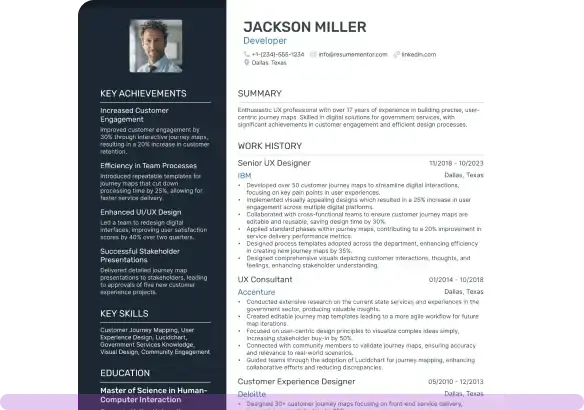Applicant Tracking System-Friendly Resume Examples

Mar 26, 2025
|
12 min read
Craft an ATS-friendly resume with confidence and bring your career to new heights. Discover simple tips and avoid common mistakes, making sure your application doesn’t get "lost in the cloud."
Rated by 348 people
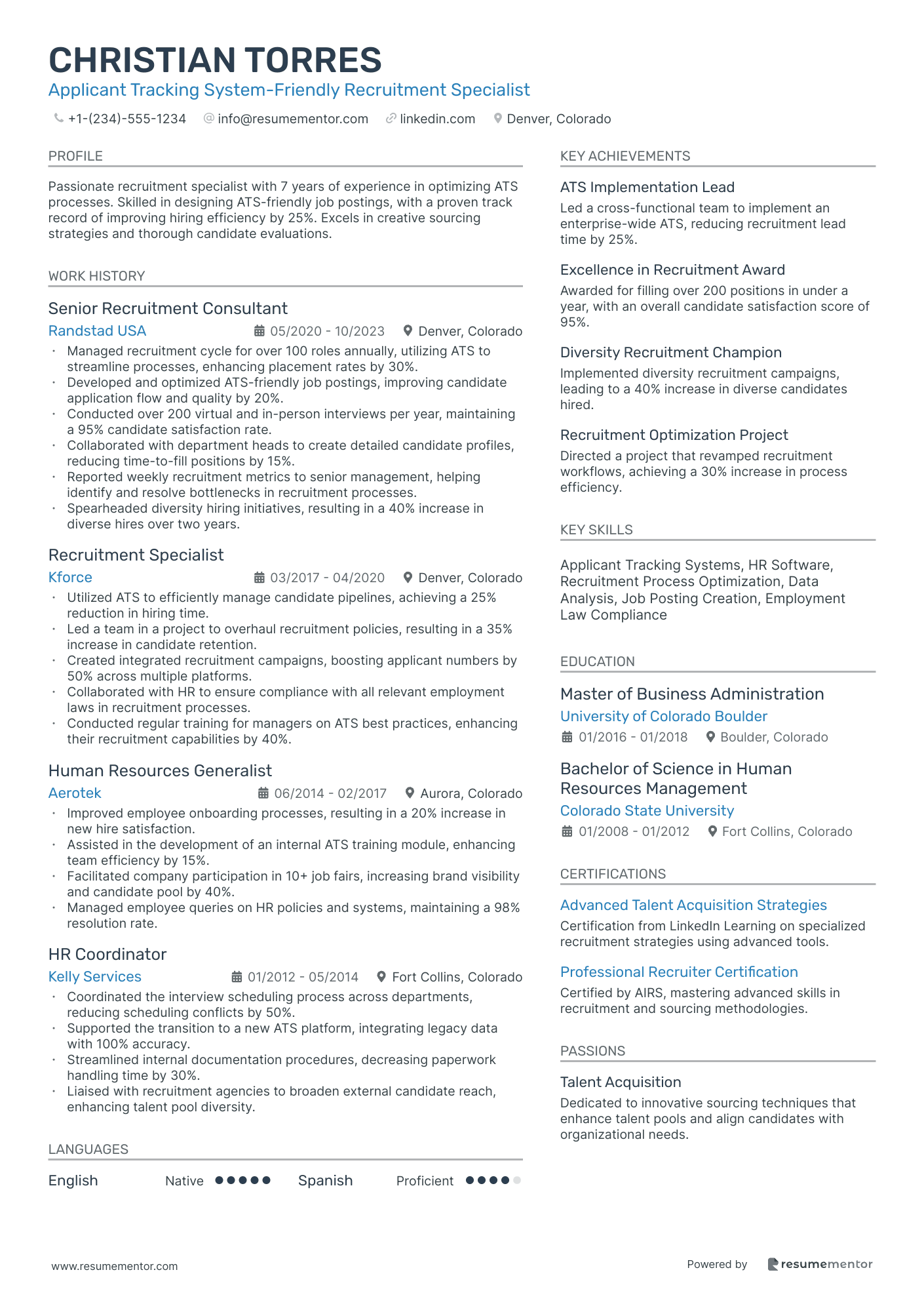
Applicant Tracking System-Friendly Recruitment Specialist
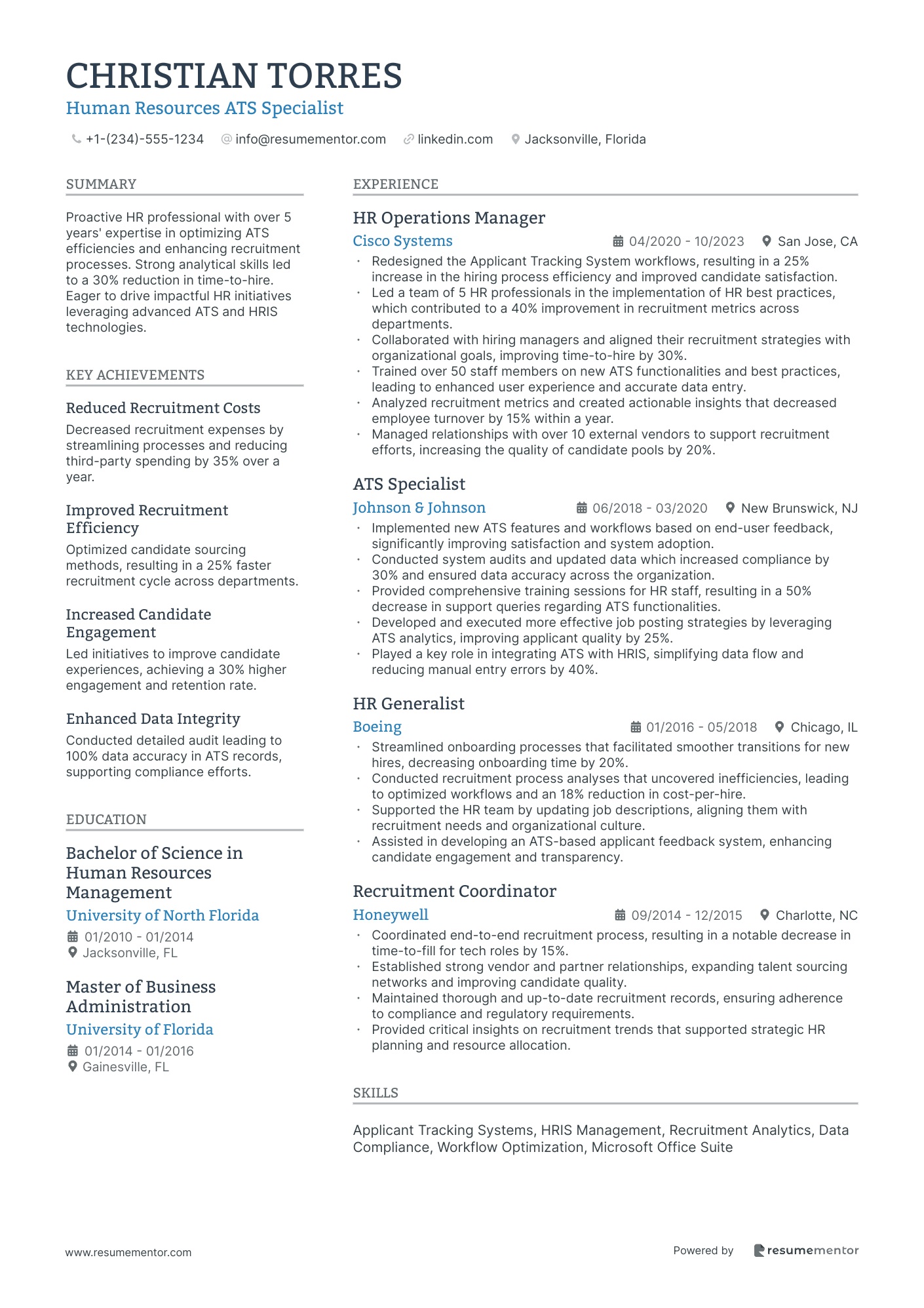
Human Resources ATS Specialist
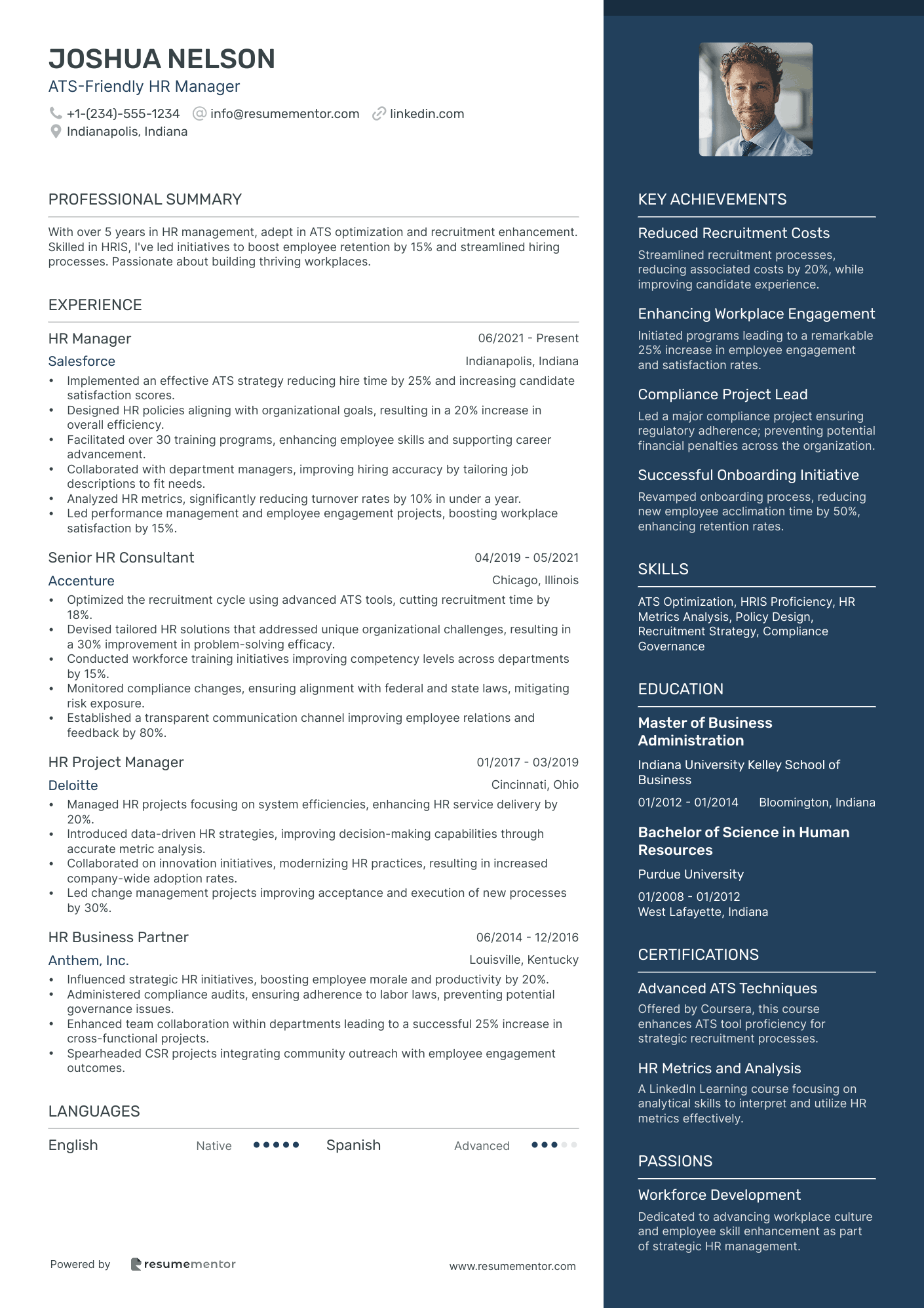
ATS-Friendly HR Manager
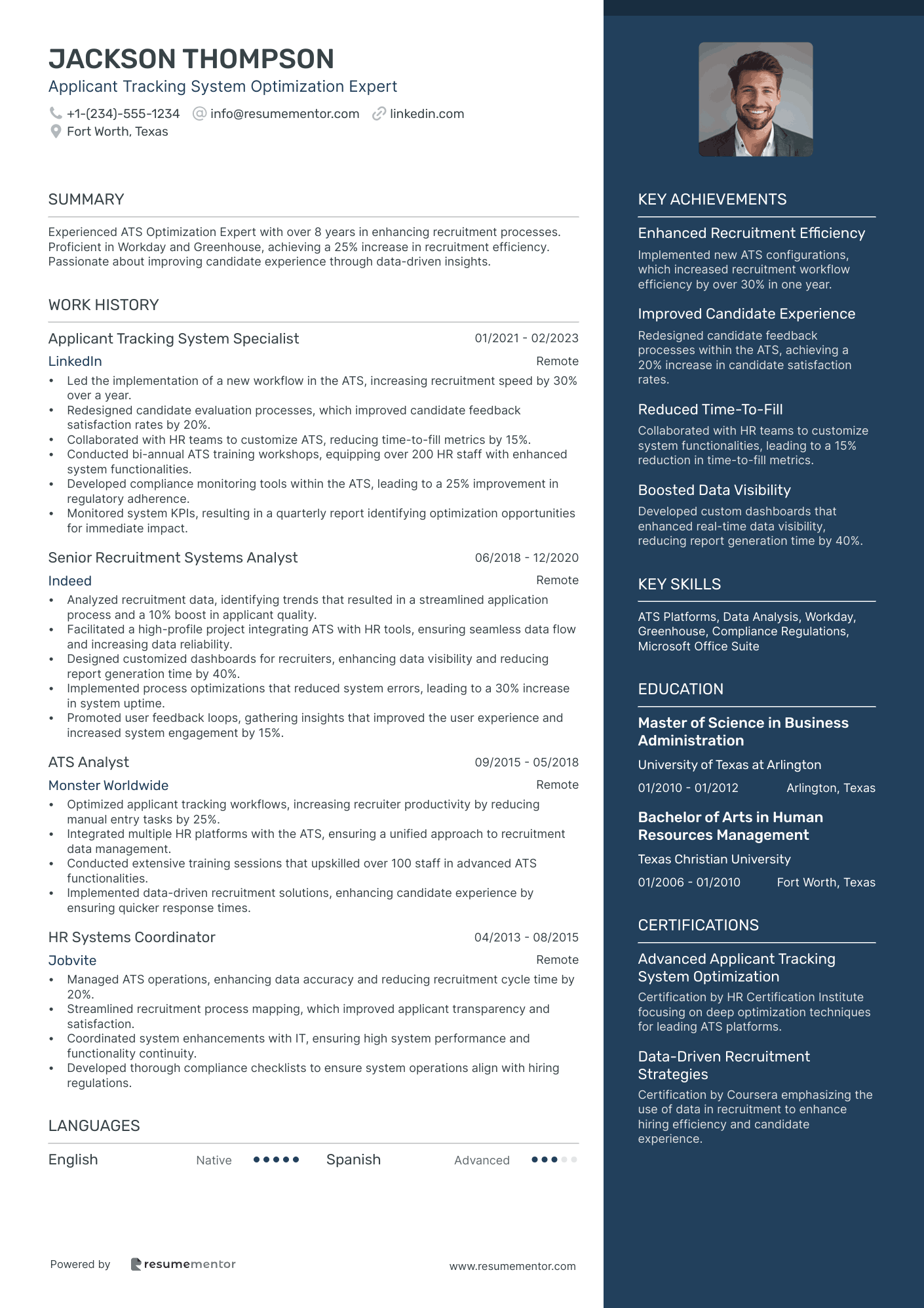
Applicant Tracking System Optimization Expert
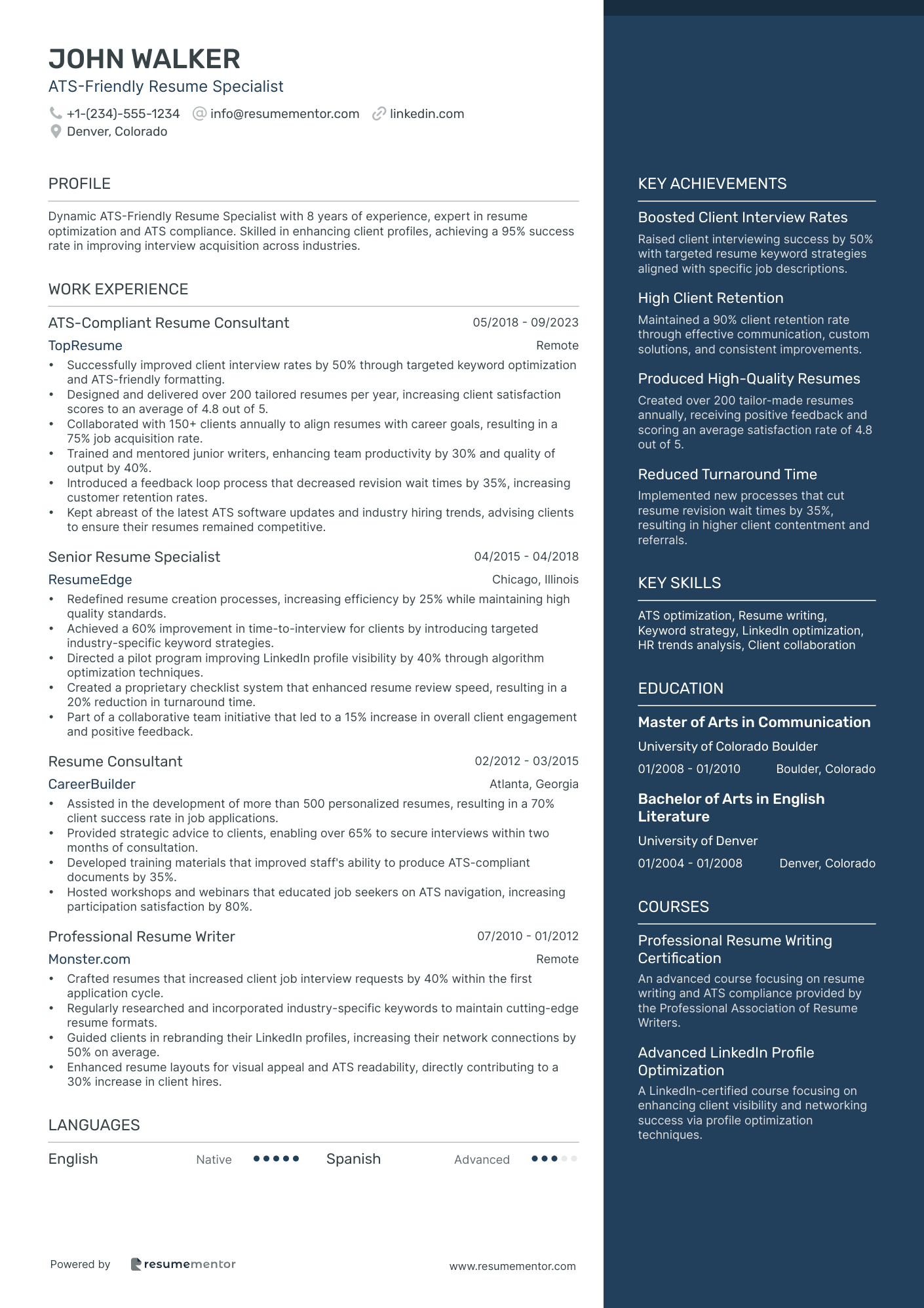
ATS-Friendly Resume Specialist
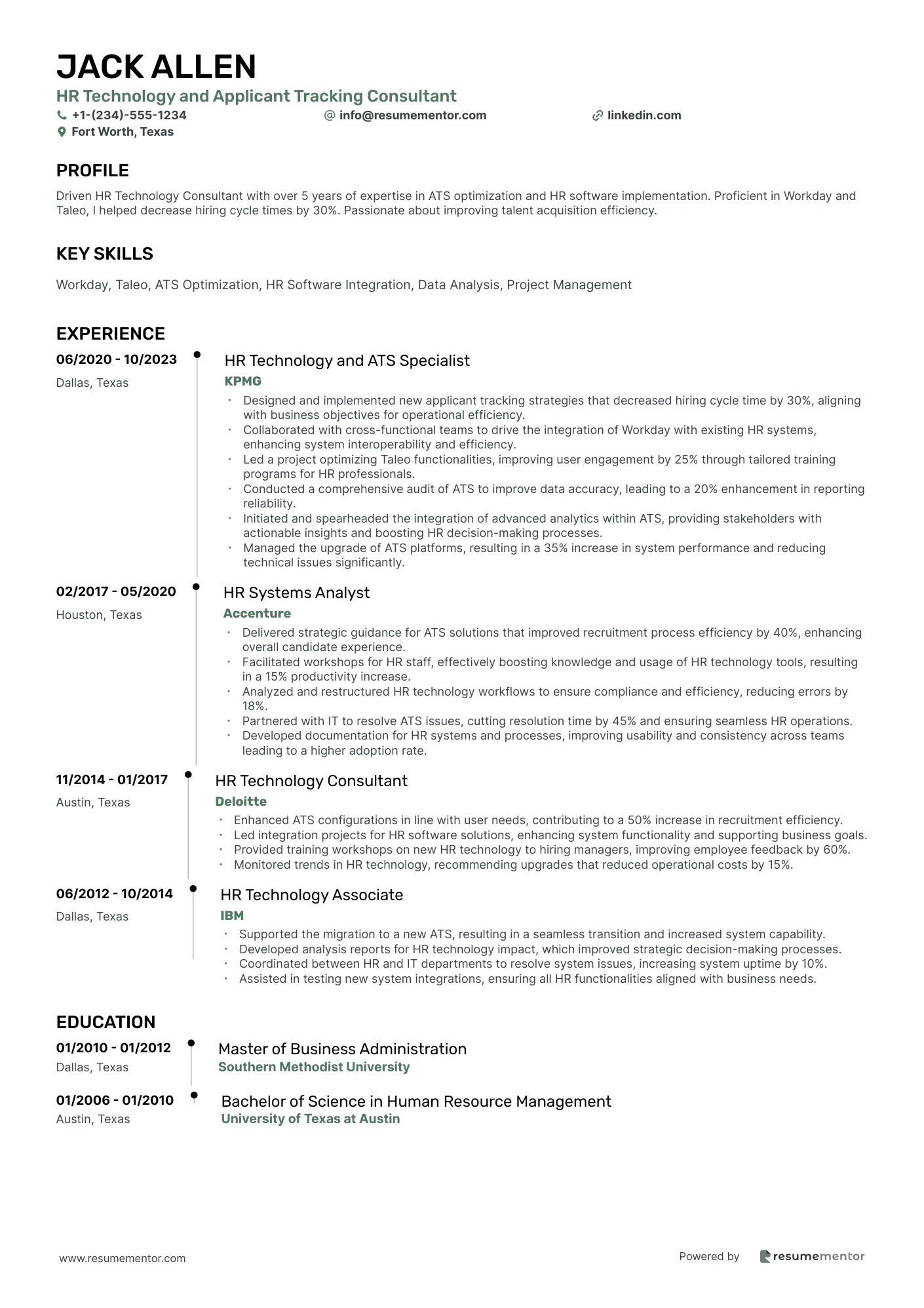
HR Technology and Applicant Tracking Consultant

Applicant Tracking System Implementation Director
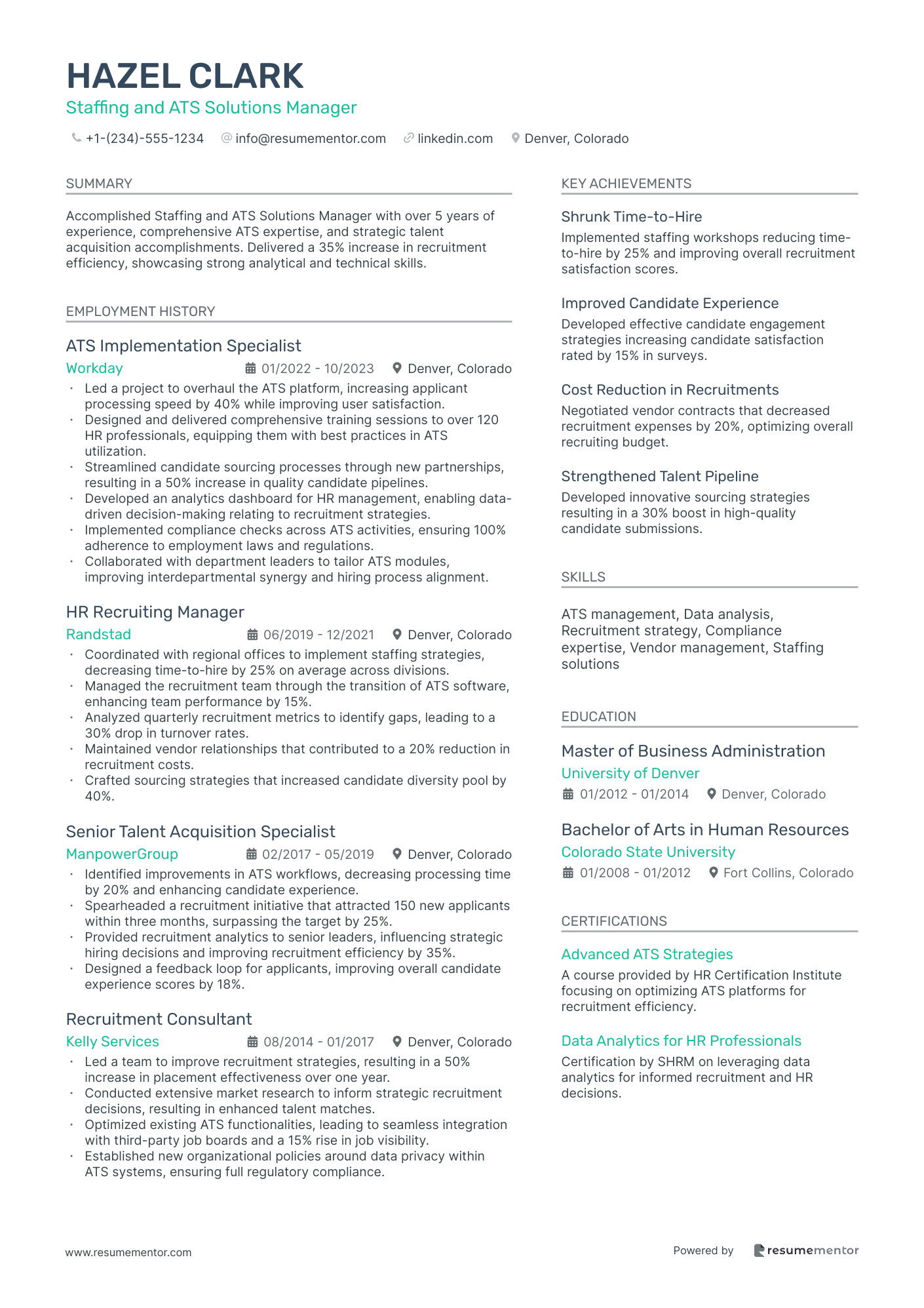
Staffing and ATS Solutions Manager
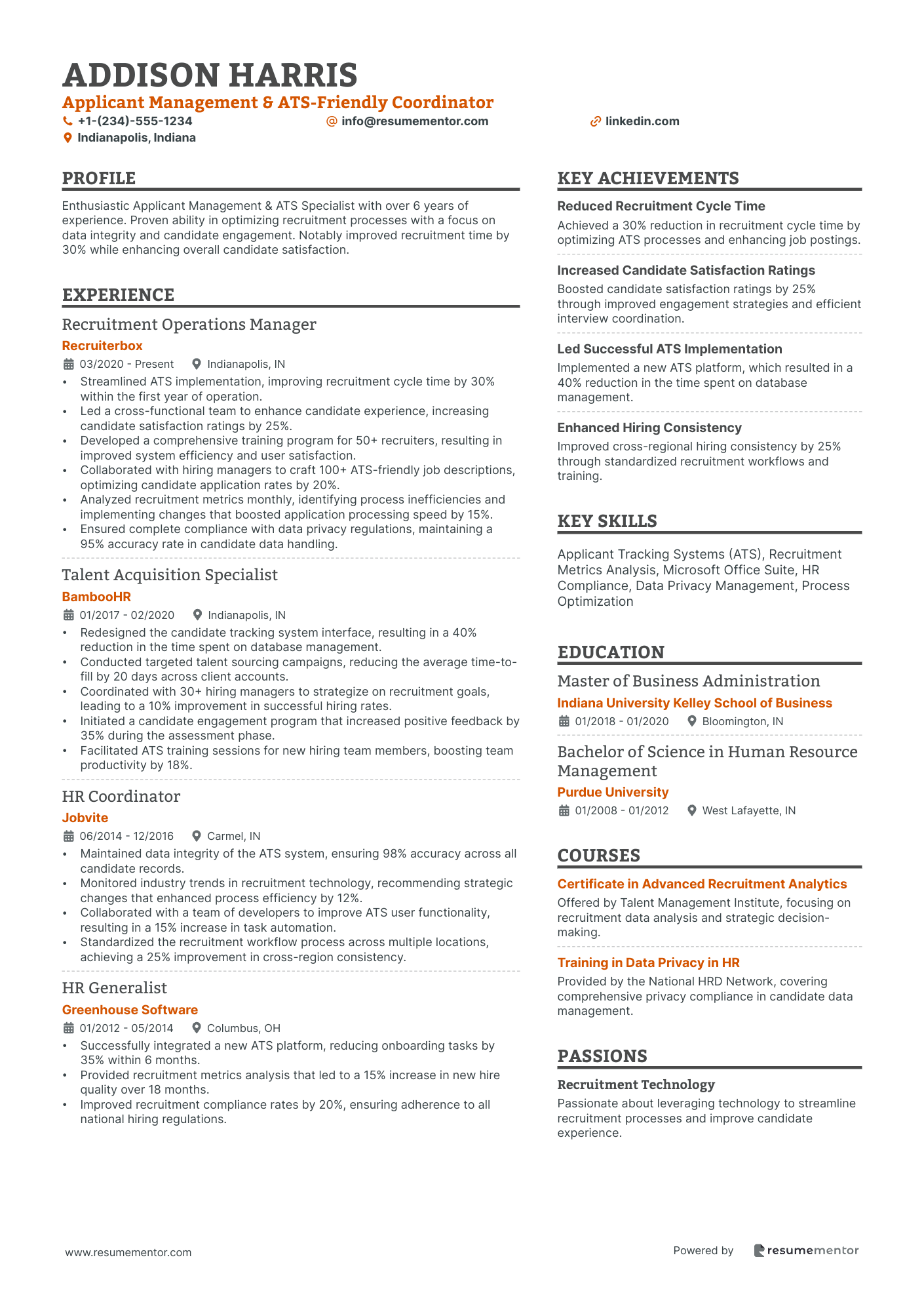
Applicant Management & ATS-Friendly Coordinator
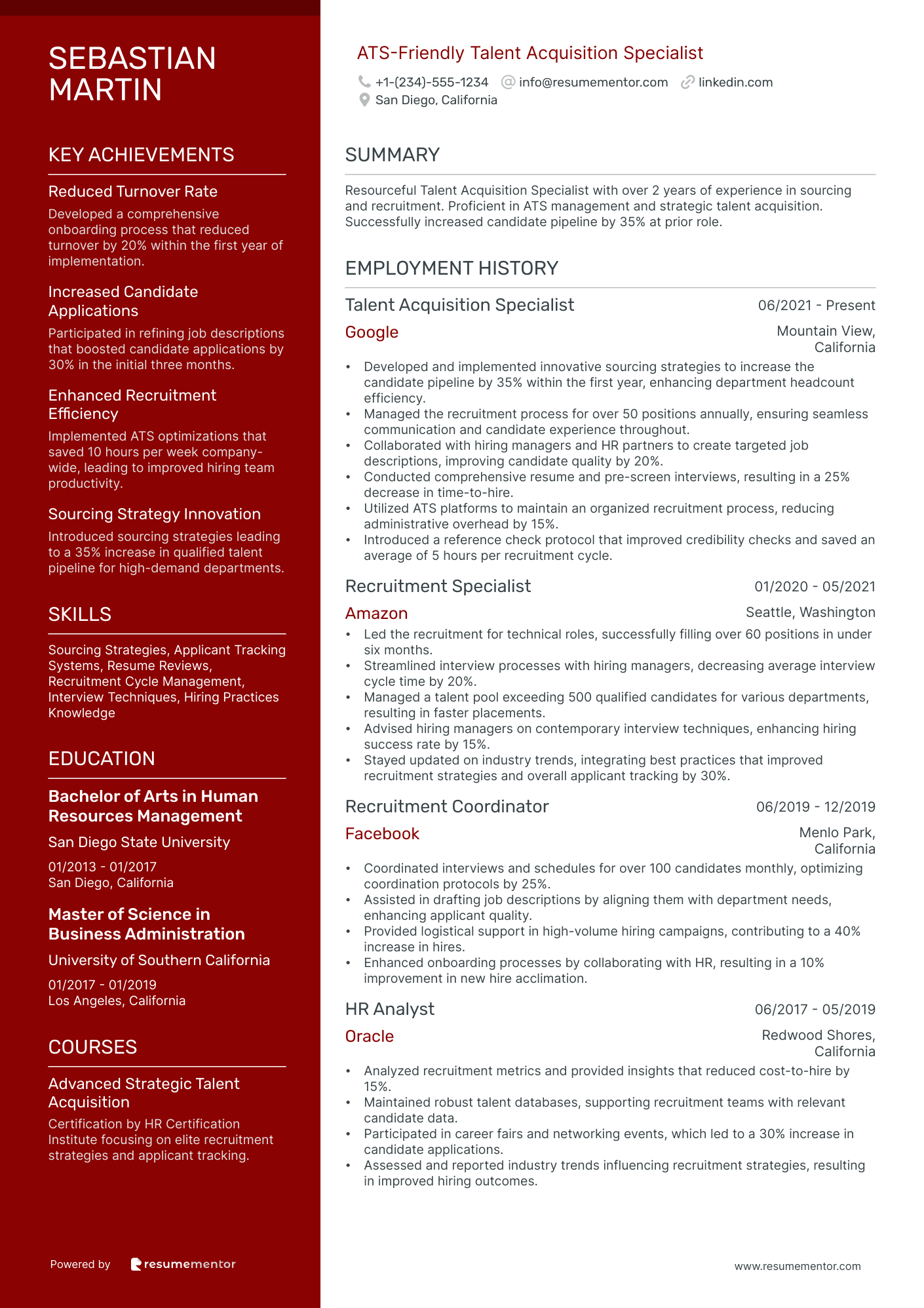
ATS-Friendly Talent Acquisition Specialist

Applicant Tracking System-Friendly Recruitment Specialist resume sample
- •Managed recruitment cycle for over 100 roles annually, utilizing ATS to streamline processes, enhancing placement rates by 30%.
- •Developed and optimized ATS-friendly job postings, improving candidate application flow and quality by 20%.
- •Conducted over 200 virtual and in-person interviews per year, maintaining a 95% candidate satisfaction rate.
- •Collaborated with department heads to create detailed candidate profiles, reducing time-to-fill positions by 15%.
- •Reported weekly recruitment metrics to senior management, helping identify and resolve bottlenecks in recruitment processes.
- •Spearheaded diversity hiring initiatives, resulting in a 40% increase in diverse hires over two years.
- •Utilized ATS to efficiently manage candidate pipelines, achieving a 25% reduction in hiring time.
- •Led a team in a project to overhaul recruitment policies, resulting in a 35% increase in candidate retention.
- •Created integrated recruitment campaigns, boosting applicant numbers by 50% across multiple platforms.
- •Collaborated with HR to ensure compliance with all relevant employment laws in recruitment processes.
- •Conducted regular training for managers on ATS best practices, enhancing their recruitment capabilities by 40%.
- •Improved employee onboarding processes, resulting in a 20% increase in new hire satisfaction.
- •Assisted in the development of an internal ATS training module, enhancing team efficiency by 15%.
- •Facilitated company participation in 10+ job fairs, increasing brand visibility and candidate pool by 40%.
- •Managed employee queries on HR policies and systems, maintaining a 98% resolution rate.
- •Coordinated the interview scheduling process across departments, reducing scheduling conflicts by 50%.
- •Supported the transition to a new ATS platform, integrating legacy data with 100% accuracy.
- •Streamlined internal documentation procedures, decreasing paperwork handling time by 30%.
- •Liaised with recruitment agencies to broaden external candidate reach, enhancing talent pool diversity.
Human Resources ATS Specialist resume sample
- •Redesigned the Applicant Tracking System workflows, resulting in a 25% increase in the hiring process efficiency and improved candidate satisfaction.
- •Led a team of 5 HR professionals in the implementation of HR best practices, which contributed to a 40% improvement in recruitment metrics across departments.
- •Collaborated with hiring managers and aligned their recruitment strategies with organizational goals, improving time-to-hire by 30%.
- •Trained over 50 staff members on new ATS functionalities and best practices, leading to enhanced user experience and accurate data entry.
- •Analyzed recruitment metrics and created actionable insights that decreased employee turnover by 15% within a year.
- •Managed relationships with over 10 external vendors to support recruitment efforts, increasing the quality of candidate pools by 20%.
- •Implemented new ATS features and workflows based on end-user feedback, significantly improving satisfaction and system adoption.
- •Conducted system audits and updated data which increased compliance by 30% and ensured data accuracy across the organization.
- •Provided comprehensive training sessions for HR staff, resulting in a 50% decrease in support queries regarding ATS functionalities.
- •Developed and executed more effective job posting strategies by leveraging ATS analytics, improving applicant quality by 25%.
- •Played a key role in integrating ATS with HRIS, simplifying data flow and reducing manual entry errors by 40%.
- •Streamlined onboarding processes that facilitated smoother transitions for new hires, decreasing onboarding time by 20%.
- •Conducted recruitment process analyses that uncovered inefficiencies, leading to optimized workflows and an 18% reduction in cost-per-hire.
- •Supported the HR team by updating job descriptions, aligning them with recruitment needs and organizational culture.
- •Assisted in developing an ATS-based applicant feedback system, enhancing candidate engagement and transparency.
- •Coordinated end-to-end recruitment process, resulting in a notable decrease in time-to-fill for tech roles by 15%.
- •Established strong vendor and partner relationships, expanding talent sourcing networks and improving candidate quality.
- •Maintained thorough and up-to-date recruitment records, ensuring adherence to compliance and regulatory requirements.
- •Provided critical insights on recruitment trends that supported strategic HR planning and resource allocation.
ATS-Friendly HR Manager resume sample
- •Implemented an effective ATS strategy reducing hire time by 25% and increasing candidate satisfaction scores.
- •Designed HR policies aligning with organizational goals, resulting in a 20% increase in overall efficiency.
- •Facilitated over 30 training programs, enhancing employee skills and supporting career advancement.
- •Collaborated with department managers, improving hiring accuracy by tailoring job descriptions to fit needs.
- •Analyzed HR metrics, significantly reducing turnover rates by 10% in under a year.
- •Led performance management and employee engagement projects, boosting workplace satisfaction by 15%.
- •Optimized the recruitment cycle using advanced ATS tools, cutting recruitment time by 18%.
- •Devised tailored HR solutions that addressed unique organizational challenges, resulting in a 30% improvement in problem-solving efficacy.
- •Conducted workforce training initiatives improving competency levels across departments by 15%.
- •Monitored compliance changes, ensuring alignment with federal and state laws, mitigating risk exposure.
- •Established a transparent communication channel improving employee relations and feedback by 80%.
- •Managed HR projects focusing on system efficiencies, enhancing HR service delivery by 20%.
- •Introduced data-driven HR strategies, improving decision-making capabilities through accurate metric analysis.
- •Collaborated on innovation initiatives, modernizing HR practices, resulting in increased company-wide adoption rates.
- •Led change management projects improving acceptance and execution of new processes by 30%.
- •Influenced strategic HR initiatives, boosting employee morale and productivity by 20%.
- •Administered compliance audits, ensuring adherence to labor laws, preventing potential governance issues.
- •Enhanced team collaboration within departments leading to a successful 25% increase in cross-functional projects.
- •Spearheaded CSR projects integrating community outreach with employee engagement outcomes.
Applicant Tracking System Optimization Expert resume sample
- •Led the implementation of a new workflow in the ATS, increasing recruitment speed by 30% over a year.
- •Redesigned candidate evaluation processes, which improved candidate feedback satisfaction rates by 20%.
- •Collaborated with HR teams to customize ATS, reducing time-to-fill metrics by 15%.
- •Conducted bi-annual ATS training workshops, equipping over 200 HR staff with enhanced system functionalities.
- •Developed compliance monitoring tools within the ATS, leading to a 25% improvement in regulatory adherence.
- •Monitored system KPIs, resulting in a quarterly report identifying optimization opportunities for immediate impact.
- •Analyzed recruitment data, identifying trends that resulted in a streamlined application process and a 10% boost in applicant quality.
- •Facilitated a high-profile project integrating ATS with HR tools, ensuring seamless data flow and increasing data reliability.
- •Designed customized dashboards for recruiters, enhancing data visibility and reducing report generation time by 40%.
- •Implemented process optimizations that reduced system errors, leading to a 30% increase in system uptime.
- •Promoted user feedback loops, gathering insights that improved the user experience and increased system engagement by 15%.
- •Optimized applicant tracking workflows, increasing recruiter productivity by reducing manual entry tasks by 25%.
- •Integrated multiple HR platforms with the ATS, ensuring a unified approach to recruitment data management.
- •Conducted extensive training sessions that upskilled over 100 staff in advanced ATS functionalities.
- •Implemented data-driven recruitment solutions, enhancing candidate experience by ensuring quicker response times.
- •Managed ATS operations, enhancing data accuracy and reducing recruitment cycle time by 20%.
- •Streamlined recruitment process mapping, which improved applicant transparency and satisfaction.
- •Coordinated system enhancements with IT, ensuring high system performance and functionality continuity.
- •Developed thorough compliance checklists to ensure system operations align with hiring regulations.
ATS-Friendly Resume Specialist resume sample
- •Successfully improved client interview rates by 50% through targeted keyword optimization and ATS-friendly formatting.
- •Designed and delivered over 200 tailored resumes per year, increasing client satisfaction scores to an average of 4.8 out of 5.
- •Collaborated with 150+ clients annually to align resumes with career goals, resulting in a 75% job acquisition rate.
- •Trained and mentored junior writers, enhancing team productivity by 30% and quality of output by 40%.
- •Introduced a feedback loop process that decreased revision wait times by 35%, increasing customer retention rates.
- •Kept abreast of the latest ATS software updates and industry hiring trends, advising clients to ensure their resumes remained competitive.
- •Redefined resume creation processes, increasing efficiency by 25% while maintaining high quality standards.
- •Achieved a 60% improvement in time-to-interview for clients by introducing targeted industry-specific keyword strategies.
- •Directed a pilot program improving LinkedIn profile visibility by 40% through algorithm optimization techniques.
- •Created a proprietary checklist system that enhanced resume review speed, resulting in a 20% reduction in turnaround time.
- •Part of a collaborative team initiative that led to a 15% increase in overall client engagement and positive feedback.
- •Assisted in the development of more than 500 personalized resumes, resulting in a 70% client success rate in job applications.
- •Provided strategic advice to clients, enabling over 65% to secure interviews within two months of consultation.
- •Developed training materials that improved staff's ability to produce ATS-compliant documents by 35%.
- •Hosted workshops and webinars that educated job seekers on ATS navigation, increasing participation satisfaction by 80%.
- •Crafted resumes that increased client job interview requests by 40% within the first application cycle.
- •Regularly researched and incorporated industry-specific keywords to maintain cutting-edge resume formats.
- •Guided clients in rebranding their LinkedIn profiles, increasing their network connections by 50% on average.
- •Enhanced resume layouts for visual appeal and ATS readability, directly contributing to a 30% increase in client hires.
HR Technology and Applicant Tracking Consultant resume sample
- •Designed and implemented new applicant tracking strategies that decreased hiring cycle time by 30%, aligning with business objectives for operational efficiency.
- •Collaborated with cross-functional teams to drive the integration of Workday with existing HR systems, enhancing system interoperability and efficiency.
- •Led a project optimizing Taleo functionalities, improving user engagement by 25% through tailored training programs for HR professionals.
- •Conducted a comprehensive audit of ATS to improve data accuracy, leading to a 20% enhancement in reporting reliability.
- •Initiated and spearheaded the integration of advanced analytics within ATS, providing stakeholders with actionable insights and boosting HR decision-making processes.
- •Managed the upgrade of ATS platforms, resulting in a 35% increase in system performance and reducing technical issues significantly.
- •Delivered strategic guidance for ATS solutions that improved recruitment process efficiency by 40%, enhancing overall candidate experience.
- •Facilitated workshops for HR staff, effectively boosting knowledge and usage of HR technology tools, resulting in a 15% productivity increase.
- •Analyzed and restructured HR technology workflows to ensure compliance and efficiency, reducing errors by 18%.
- •Partnered with IT to resolve ATS issues, cutting resolution time by 45% and ensuring seamless HR operations.
- •Developed documentation for HR systems and processes, improving usability and consistency across teams leading to a higher adoption rate.
- •Enhanced ATS configurations in line with user needs, contributing to a 50% increase in recruitment efficiency.
- •Led integration projects for HR software solutions, enhancing system functionality and supporting business goals.
- •Provided training workshops on new HR technology to hiring managers, improving employee feedback by 60%.
- •Monitored trends in HR technology, recommending upgrades that reduced operational costs by 15%.
- •Supported the migration to a new ATS, resulting in a seamless transition and increased system capability.
- •Developed analysis reports for HR technology impact, which improved strategic decision-making processes.
- •Coordinated between HR and IT departments to resolve system issues, increasing system uptime by 10%.
- •Assisted in testing new system integrations, ensuring all HR functionalities aligned with business needs.
Applicant Tracking System Implementation Director resume sample
- •Led ATS implementation projects across 15 geographical locations, resulting in a 20% decrease in system downtime.
- •Collaborated with HR and IT to customize ATS configurations, boosting recruitment speed by 30%.
- •Managed vendor relations, negotiating contracts that reduced software costs by 15% over three years.
- •Conducted training sessions for over 200 HR personnel, increasing ATS user adoption rates by 45%.
- •Implemented post-integration support mechanisms, reducing troubleshooting requests by half within six months.
- •Initiated continuous improvement initiatives that enhanced system efficiency, contributing to a 25% reduction in hiring cycle time.
- •Oversaw multi-phase ATS projects, achieving a 93% on-time delivery rate within budget constraints.
- •Strategized with cross-functional teams to align ATS with recruitment objectives, fostering a 35% increase in candidate throughput.
- •Spearheaded the design of user training programs, resulting in a 40% improvement in HR team competence.
- •Optimized software features to streamline processes, enhancing recruiter productivity by 20%.
- •Managed compliance data handling, ensuring all ATS integrations adhered to privacy regulations, thereby avoiding potential legal risks.
- •Coordinated deployment of ATS with a focus on seamless integration into existing HR frameworks.
- •Improved data management practices, ensuring 98% accuracy in storing and retrieving candidate credentials.
- •Developed project documentation standards adopted company-wide, reducing planning phase duration by 25%.
- •Enhanced vendor collaboration processes, leading to a 12% cost reduction in software expenditures.
- •Facilitated the adoption of new recruitment technologies, achieving a 15% increase in recruitment efficiency.
- •Monitored ATS system post-launch, providing technical support and reducing downtime by 50%.
- •Assisted in the creation of system user guides that improved user satisfaction ratings by 30%.
- •Analyzed industry trends to inform future ATS enhancements, contributing to a long-term strategic roadmap.
Staffing and ATS Solutions Manager resume sample
- •Led a project to overhaul the ATS platform, increasing applicant processing speed by 40% while improving user satisfaction.
- •Designed and delivered comprehensive training sessions to over 120 HR professionals, equipping them with best practices in ATS utilization.
- •Streamlined candidate sourcing processes through new partnerships, resulting in a 50% increase in quality candidate pipelines.
- •Developed an analytics dashboard for HR management, enabling data-driven decision-making relating to recruitment strategies.
- •Implemented compliance checks across ATS activities, ensuring 100% adherence to employment laws and regulations.
- •Collaborated with department leaders to tailor ATS modules, improving interdepartmental synergy and hiring process alignment.
- •Coordinated with regional offices to implement staffing strategies, decreasing time-to-hire by 25% on average across divisions.
- •Managed the recruitment team through the transition of ATS software, enhancing team performance by 15%.
- •Analyzed quarterly recruitment metrics to identify gaps, leading to a 30% drop in turnover rates.
- •Maintained vendor relationships that contributed to a 20% reduction in recruitment costs.
- •Crafted sourcing strategies that increased candidate diversity pool by 40%.
- •Identified improvements in ATS workflows, decreasing processing time by 20% and enhancing candidate experience.
- •Spearheaded a recruitment initiative that attracted 150 new applicants within three months, surpassing the target by 25%.
- •Provided recruitment analytics to senior leaders, influencing strategic hiring decisions and improving recruitment efficiency by 35%.
- •Designed a feedback loop for applicants, improving overall candidate experience scores by 18%.
- •Led a team to improve recruitment strategies, resulting in a 50% increase in placement effectiveness over one year.
- •Conducted extensive market research to inform strategic recruitment decisions, resulting in enhanced talent matches.
- •Optimized existing ATS functionalities, leading to seamless integration with third-party job boards and a 15% rise in job visibility.
- •Established new organizational policies around data privacy within ATS systems, ensuring full regulatory compliance.
Applicant Management & ATS-Friendly Coordinator resume sample
- •Streamlined ATS implementation, improving recruitment cycle time by 30% within the first year of operation.
- •Led a cross-functional team to enhance candidate experience, increasing candidate satisfaction ratings by 25%.
- •Developed a comprehensive training program for 50+ recruiters, resulting in improved system efficiency and user satisfaction.
- •Collaborated with hiring managers to craft 100+ ATS-friendly job descriptions, optimizing candidate application rates by 20%.
- •Analyzed recruitment metrics monthly, identifying process inefficiencies and implementing changes that boosted application processing speed by 15%.
- •Ensured complete compliance with data privacy regulations, maintaining a 95% accuracy rate in candidate data handling.
- •Redesigned the candidate tracking system interface, resulting in a 40% reduction in the time spent on database management.
- •Conducted targeted talent sourcing campaigns, reducing the average time-to-fill by 20 days across client accounts.
- •Coordinated with 30+ hiring managers to strategize on recruitment goals, leading to a 10% improvement in successful hiring rates.
- •Initiated a candidate engagement program that increased positive feedback by 35% during the assessment phase.
- •Facilitated ATS training sessions for new hiring team members, boosting team productivity by 18%.
- •Maintained data integrity of the ATS system, ensuring 98% accuracy across all candidate records.
- •Monitored industry trends in recruitment technology, recommending strategic changes that enhanced process efficiency by 12%.
- •Collaborated with a team of developers to improve ATS user functionality, resulting in a 15% increase in task automation.
- •Standardized the recruitment workflow process across multiple locations, achieving a 25% improvement in cross-region consistency.
- •Successfully integrated a new ATS platform, reducing onboarding tasks by 35% within 6 months.
- •Provided recruitment metrics analysis that led to a 15% increase in new hire quality over 18 months.
- •Improved recruitment compliance rates by 20%, ensuring adherence to all national hiring regulations.
ATS-Friendly Talent Acquisition Specialist resume sample
- •Developed and implemented innovative sourcing strategies to increase the candidate pipeline by 35% within the first year, enhancing department headcount efficiency.
- •Managed the recruitment process for over 50 positions annually, ensuring seamless communication and candidate experience throughout.
- •Collaborated with hiring managers and HR partners to create targeted job descriptions, improving candidate quality by 20%.
- •Conducted comprehensive resume and pre-screen interviews, resulting in a 25% decrease in time-to-hire.
- •Utilized ATS platforms to maintain an organized recruitment process, reducing administrative overhead by 15%.
- •Introduced a reference check protocol that improved credibility checks and saved an average of 5 hours per recruitment cycle.
- •Led the recruitment for technical roles, successfully filling over 60 positions in under six months.
- •Streamlined interview processes with hiring managers, decreasing average interview cycle time by 20%.
- •Managed a talent pool exceeding 500 qualified candidates for various departments, resulting in faster placements.
- •Advised hiring managers on contemporary interview techniques, enhancing hiring success rate by 15%.
- •Stayed updated on industry trends, integrating best practices that improved recruitment strategies and overall applicant tracking by 30%.
- •Coordinated interviews and schedules for over 100 candidates monthly, optimizing coordination protocols by 25%.
- •Assisted in drafting job descriptions by aligning them with department needs, enhancing applicant quality.
- •Provided logistical support in high-volume hiring campaigns, contributing to a 40% increase in hires.
- •Enhanced onboarding processes by collaborating with HR, resulting in a 10% improvement in new hire acclimation.
- •Analyzed recruitment metrics and provided insights that reduced cost-to-hire by 15%.
- •Maintained robust talent databases, supporting recruitment teams with relevant candidate data.
- •Participated in career fairs and networking events, which led to a 30% increase in candidate applications.
- •Assessed and reported industry trends influencing recruitment strategies, resulting in improved hiring outcomes.
Navigating today’s job market can feel like assembling a complex puzzle—every piece of your resume must fit perfectly to make an impact. At the heart of this process are applicant tracking systems (ATS), which act as gatekeepers by scanning resumes before reaching hiring managers. To ensure your impressive medical expertise or technical skills aren’t lost in the shuffle, aligning your resume with ATS criteria is crucial.
Creating an ATS-friendly resume means going beyond a simple list of jobs and skills. The right format is vital here, as it ensures your information is clear and efficient for the ATS to process. Using a resume template gives you that structural edge, positioning your resume to stand out from the stack.
Understanding how ATS functions might seem like learning a new language, yet the effort is highly rewarding. It’s about crafting content that resonates with both machines and human recruiters. Thoughtfully integrating keywords from job listings in a natural way is important, as is maintaining clarity with concise writing and clear headings. Avoid overly complex designs, because every detail matters. By mastering these components, an ATS-friendly resume can open the door to exciting career opportunities.
Key Takeaways
- Craft an ATS-friendly resume by aligning its content with job-specific keywords and maintaining a clear, efficient structure.
- Use a reverse chronological format for work experience, incorporating measurable achievements and role-specific keywords.
- Choose modern, clean fonts like Raleway, Lato, or Montserrat and always save your resume as a PDF to preserve formatting.
- Include both hard and soft skills tailored to the job description to boost ATS compatibility and appeal to hiring managers.
- Highlight education, certifications, and optional extra sections like volunteer work or languages, making them relevant to the position.
What to focus on when writing your applicant tracking system-friendly resume
An applicant tracking system-friendly resume should clearly highlight your qualifications to align seamlessly with the job description. You need to demonstrate that you're an ideal fit for the role by using keywords and phrases specific to the industry and position.
How to structure your applicant tracking system-friendly resume
- Contact Information: Start with your full name, phone number, email address, and optionally, your LinkedIn profile. Make sure this section is straightforward so that every system can read it easily. Using a professional email address reinforces your attention to detail. Double-check that these details are correct to make positive connections with potential employers.
- Professional Summary: After your contact info, include a brief paragraph capturing your top skills and experiences. This section sets the tone by focusing on specific expertise like "project management experience" for relevant roles, ensuring your summary is both keyword-rich and job-targeted. Highlight your top achievements or strengths in a compelling way that makes recruiters eager to learn more about your work history.
- Work Experience: Next, outline your job history in reverse order, using bullet points for clarity. Here, detail your achievements and responsibilities by weaving in industry-specific terms. Highlight measurable accomplishments, such as “increased sales by 30% in H1,” to give weight to your experience. Aim to showcase how your previous positions have prepared you for the role you’re applying for.
- Education: Follow up with your educational background, listing degrees, institutions, and any honors received. Be sure to include essential certifications for your field, such as “Certified Public Accountant” in accounting, to reinforce your qualifications. Emphasize any coursework or projects that are particularly relevant to the job title, highlighting your foundation in the field.
- Skills: Round out your resume by highlighting specific skills that match the job. Instead of using generic terms, focus on role-specific abilities, like "clinical assessment" for nurses, ensuring these skills align with the job description. Consider including both hard and soft skills to show you’re well-rounded and adaptable.
Bringing these sections together in a cohesive and structured format is crucial for a compelling application—next, we’ll delve deeper into each section to ensure your resume stands out in an applicant tracking system.
Which resume format to choose
Creating a resume that grabs attention starts with choosing the right format. For most job titles, a reverse chronological format is effective. It lays out your work history from the most recent job to the earliest, allowing both employers and applicant tracking systems to easily follow your career path and gauge your experience.
The font you use can also impact your resume's effectiveness. Raleway, Lato, and Montserrat are excellent choices for any job title. These fonts are modern and clean, making your resume easy to read. Their straightforward style also helps applicant tracking systems process your information accurately, increasing your chances of being noticed.
File format is crucial, too. Always save your resume as a PDF. This ensures that your formatting stays consistent, whether it's viewed on a desktop, laptop, or mobile device. A PDF maintains the integrity of your layout, making it a reliable choice for any resume.
Don't forget about margins. Stick to a one-inch margin on all sides of your document. This standard margin size keeps your resume looking organized and prevents any important details from being cut off when printed, ensuring a professional presentation every time.
By paying attention to these details, your resume will effectively pass through applicant tracking systems and make a strong impression on hiring managers.
How to write a quantifiable resume experience section
Creating a resume that is applicant tracking system-friendly involves strategically highlighting your career achievements. The experience section of your resume plays a critical role, as it demonstrates the impact you’ve made in previous roles. To keep your resume current and relevant, arrange this section in reverse chronological order, focusing on your work from the last 10-15 years. Select job titles that closely align with the positions you’re targeting, ensuring they resonate with the keywords in job ads. Tailoring your resume for each application is essential, merging skills and experiences that mirror the job description. Using strong action verbs like "achieved," "led," "developed," and "improved" helps convey the impact of your contributions. Highlighting measurable successes not only helps your resume pass ATS filters but also makes an impression in interviews.
- •Increased revenue by 30% year-over-year by optimizing digital campaigns.
- •Led a team of 10 to execute successful marketing strategies for product launches.
- •Developed a content marketing strategy that increased engagement by 50%.
- •Implemented a CRM system, enhancing customer interactions by 20%.
This experience section stands out by weaving together measurable results with relevant roles, keeping content aligned with ATS requirements. Each listed position showcases recent experiences, ensuring that the content remains timely and pertinent. The use of action verbs effectively highlights leadership and successful outcomes, with every point making a significant impact. By integrating essential keywords from marketing job descriptions, the section ensures compatibility with both ATS and human readers. The natural flow of information emphasizes your team and leadership skills supported by quantifiable achievements, effectively positioning you as a strong candidate in both automated systems and face-to-face evaluations.
Skills-Focused resume experience section
A skills-focused project manager resume experience section should effectively showcase your work history in a clear and compelling manner. Begin by listing your most recent roles first, ensuring each entry is easy to scan. Use bullet points instead of lengthy descriptions to highlight the skills and accomplishments that made a significant impact. Focus on specific tasks where you've excelled and highlight the outcomes you achieved, using numbers where possible. This approach allows you to seamlessly connect your skills with those mentioned in the job description while keeping your language simple and direct.
For each entry, select a job title that accurately reflects your experience, and pair it with the duration and company. Craft bullet points that emphasize what you did to make a difference, whether by saving money, streamlining processes, or exceeding targets. Use action verbs to bring your accomplishments to life and ensure each point reinforces the skills you want to highlight. Finally, review your section for any errors to ensure your resume presents you as a polished and professional candidate.
Project Manager
ABC Solutions
June 2020 - August 2023
- Led a cross-functional team of 10 members to complete three major projects ahead of schedule.
- Negotiated with vendors to cut costs by 15%, leading to significant budget savings.
- Implemented a new project tracking system that boosted efficiency by 30%.
- Trained new staff on best practices, improving team productivity by 25%.
Customer-Focused resume experience section
A customer-focused resume experience section should clearly communicate your ability to meet and exceed customer needs. Begin by listing your job title, the company's name, and the dates you worked there. This structured layout helps applicant tracking systems quickly recognize your experience. Use simple language that corresponds with the skills needed for customer-focused positions. Your aim is to showcase how effectively you have addressed customer needs, solved issues, and enhanced service quality.
When crafting bullet points, focus on measurable achievements and detail the specific actions you took to attain them. Start with action words like "resolved" and "improved" to highlight your accomplishments in customer service. Link your experiences to the job description, illustrating your proficiency in crucial areas like communication and problem-solving. This approach not only boosts your visibility in searches but also captures the attention of hiring managers with your demonstrated customer service strengths.
Customer Support Specialist
Tech Solutions Inc.
Jan 2020 - Present
- Resolved an average of 95% of customer complaints within the first interaction.
- Implemented a new CRM process that improved customer follow-up times by 20%.
- Trained and supervised a team of 10 junior representatives, enhancing customer satisfaction scores by 15%.
- Received Employee of the Month awards three times for outstanding customer service.
Growth-Focused resume experience section
A Growth-Focused Marketing Specialist resume experience section should clearly highlight how you've contributed to your company's improvement, whether through boosting sales, enhancing user engagement, or streamlining processes. Use simple, direct language to describe the impact of your work, starting each entry with the main goal of your role and supporting it with specific examples. With measurable outcomes and clear language, your resume will attract hiring managers' attention and effectively pass through automated filters.
Consider the skills or techniques you applied to drive growth in your previous roles. Whether you led a successful project, managed a high-performing team, or introduced innovative strategies, these accomplishments should be highlighted with quantifiable results. Demonstrating your growth mindset and the value you provided to past employers can be powerful. Active verbs that emphasize outcomes will engage readers right from the start. The example below shows how to format your experience in an easily readable and impactful way.
Marketing Specialist
Tech Innovators LLC
2020–2023
- Increased brand engagement by 40% through targeted social media campaigns, which led to a 25% rise in weekly leads.
- Led a team of 5 in crafting and implementing new digital marketing strategies, boosting revenue by 15% in one year.
- Streamlined the content creation process, cutting turnaround time by 30% and enhancing team efficiency.
- Developed a customer feedback system, increasing satisfaction ratings by 20% over six months.
Achievement-Focused resume experience section
An achievement-focused resume experience section should seamlessly convey your professional journey and accomplishments in a way that's accessible to both people and applicant tracking systems (ATS). Start by using clear and industry-standard job titles and company names so ATS software can recognize your roles accurately. Stick to simple formatting with basic fonts and avoid complex elements like tables or images to maintain a clean layout.
For each bullet point, delve into specific achievements or improvements you spearheaded, rather than just listing tasks. Use strong action verbs and quantify your successes to make your contributions tangible and impactful. This approach helps potential employers easily grasp the value you brought to previous roles. Additionally, integrating keywords from your target job description will ensure your resume stands out in ATS searches, boosting your chances of getting noticed.
Project Manager
Tech Innovations Inc.
Jan 2020 - Dec 2022
- Led a team of 10 in delivering a $2M infrastructure project under budget by 15%.
- Implemented new project tracking software that increased team efficiency by 30%.
- Coordinated cross-department initiatives, resulting in a 25% boost in productivity.
- Received Employee of the Year award in 2021 for outstanding project leadership.
Write your applicant tracking system-friendly resume summary section
A results-focused marketing resume summary should instantly capture the essence of your skills and career achievements. It’s essential for it to quickly convey your most relevant accomplishments and expertise. Highlighting these key elements allows you to showcase the impact you've had over your career. For those with significant experience, a resume summary effectively demonstrates your proficiency and the influence you've exerted in your field.
When you're early in your career, opt for a resume objective that clearly outlines your goals alongside your relevant skills. This can provide valuable context and direction, appealing particularly to entry-level roles. Understanding the distinction between a resume summary, objective, or profile is crucial. While a resume objective is ideal for stating career goals, a resume profile offers a broader view of your qualifications. A summary of qualifications, meanwhile, lists your key achievements and skills as bullet points, giving each applicant a chance to present their strengths from different angles.
Here’s a standout example of an applicant tracking system-friendly resume summary for marketing professionals:
This summary is effective because it employs specific metrics to highlight skills and achievements. Demonstrating real results through numbers not only catches the eye but also appeals to both hiring managers and tracking systems. To achieve a similar impact, focus on achievements that reflect your influence and detail them with precision. Tailoring your summary to align with the job description while emphasizing the skills the company seeks can make a significant difference.
Employ clear and straightforward language, steering clear of jargon, to maintain accessibility. Utilize strong action verbs to convey confidence and enthusiasm. As you perfect your resume, remember that a well-crafted summary can decisively open doors and distinguish you from the crowd.
Listing your applicant tracking system-friendly skills on your resume
An applicant tracking system (ATS)-focused resume should include a carefully crafted skills section. This section is crucial because it helps your resume get past initial screenings by highlighting the strengths and abilities you're bringing to the table. Skills can stand alone or be integrated into your experience and summary sections. By emphasizing both strengths and soft skills, you show your interpersonal and problem-solving abilities, while hard skills highlight specific, teachable competencies like technical expertise or project management.
When creating an ATS-friendly resume, skills and strengths serve as important keywords that help your application make it through the digital gatekeepers. Align your terminology with job descriptions so recruiters can easily spot what they’re looking for. To illustrate, here’s an example of a standalone skills section:
This skills section is well-crafted because it includes a mix of hard and soft skills likely to align with ATS keywords. Featuring eight relevant skills increases your chances of capturing attention. The skills listed are clear, concise, and cover a range from technical to leadership, providing a well-rounded profile.
Best hard skills to feature on your applicant tracking system-friendly resume
Having relevant hard skills on your resume showcases your specific technical competencies. These skills demonstrate your ability to perform essential job tasks effectively.
Hard Skills
- Data Analysis
- SEO/SEM
- Programming Languages (e.g., Python, Java)
- Project Management
- Social Media Management
- UX/UI Design
- Database Management
- Cloud Computing
- IT Network Security
- Technical Support
- Copywriting
- Financial Forecasting
- Software Development
- Quality Assurance
- Digital Marketing
Best soft skills to feature on your applicant tracking system-friendly resume
Highlighting soft skills reflects your ability to interact well with others and succeed in a team setting. These skills convey that you can handle change, solve problems innovatively, and thrive in any work environment.
Soft Skills
- Communication
- Leadership
- Team Collaboration
- Problem Solving
- Time Management
- Emotional Intelligence
- Flexibility
- Adaptability
- Critical Thinking
- Empathy
- Creativity
- Conflict Resolution
- Decision Making
- Stress Management
- Motivation
How to include your education on your resume
An education section is a vital piece of your resume, particularly for an applicant tracking system (ATS). These systems scan resumes to match the qualifications needed for jobs. Tailor your education information to match the job you're applying for. Leave out any courses or degrees that don’t relate to the job.
If you're including a GPA, only list it if it's above a 3.0, and always provide a context by mentioning the scale, like 4.0. For academic honors like cum laude, include it immediately after your degree. When writing your degree, spell it out fully followed by any abbreviations. Use the correct format by listing the degree first, then the institution, the location if needed, and the years attended.
Here is an example of how not to write an education section:
For a better example, consider the following:
This example effectively highlights a relevant degree for a software job and showcases the applicant's honors and strong GPA, making it likely to pass ATS scans.
How to include applicant tracking system-friendly certificates on your resume
Including a certificates section on your resume is crucial for making a strong first impression, especially with an applicant tracking system (ATS). To craft an ATS-friendly section, list the name of each certificate clearly and concisely. Include the date of issuance to show its relevance and add the issuing organization to verify its legitimacy. Certificates can also be highlighted in the header to immediately flag your qualifications. For example, a project manager might include "PMP Certified" next to their name.
Here's a good example of a standalone certificate section:
This example demonstrates solid choices for a project manager role. Both certificates are highly relevant and reputable in the field, which verifies your commitment and skills. Listing the full name and the issuing entity boosts credibility and makes it easy for ATS systems to pick them up. Including such a section on your resume optimizes your chances of standing out in a pool of candidates.
Extra sections to include on your applicant tracking system-friendly resume
Creating a standout resume involves more than just listing your education and work experience. Including certain sections can enhance your application and help you make a memorable impression on potential employers.
- Language section — Highlighting additional languages you speak shows diverse skills and cultural adaptability.
- Hobbies and interests section — Sharing relevant hobbies can make you more relatable and demonstrate your passion for particular areas.
- Volunteer work section — Detailing volunteer experiences underscores your community commitment and indicates strong soft skills.
- Books section — Listing your favorite books or those that have influenced you can reflect your intellectual curiosity and industry knowledge.
Strategically incorporating these sections into your resume can differentiate you from other candidates. Tailor each section to align with the job description and showcase your unique capabilities. Use concise, impactful language to effectively convey your strengths to potential employers.
In Conclusion
In conclusion, crafting an applicant tracking system (ATS)-friendly resume is a vital step in navigating the modern job market. By aligning your resume's format and content with ATS criteria, you can enhance your chances of standing out to both machines and human recruiters. Remember, the cornerstone of an effective resume is clear, concise information that showcases your qualifications and achievements. Adopting a reverse chronological format and employing modern, readable fonts ensures your resume is easily processed by ATS and appealing to hiring managers. Focus on measurable successes and choose active verbs to communicate your contributions compellingly. Whether you're highlighting experience, education, or skills, tailor each section to the job description to showcase your fit for the role. Additional sections like languages, volunteer work, or hobbies can further demonstrate your unique skills and character. Attention to detail, such as correct margins and consistent formatting, signals professionalism. As you refine your resume, keep your audience in mind—both the digital gatekeepers and the individuals who will ultimately decide your professional future. An ATS-friendly and well-crafted resume can be your key to unlocking exciting career opportunities.
Related Articles
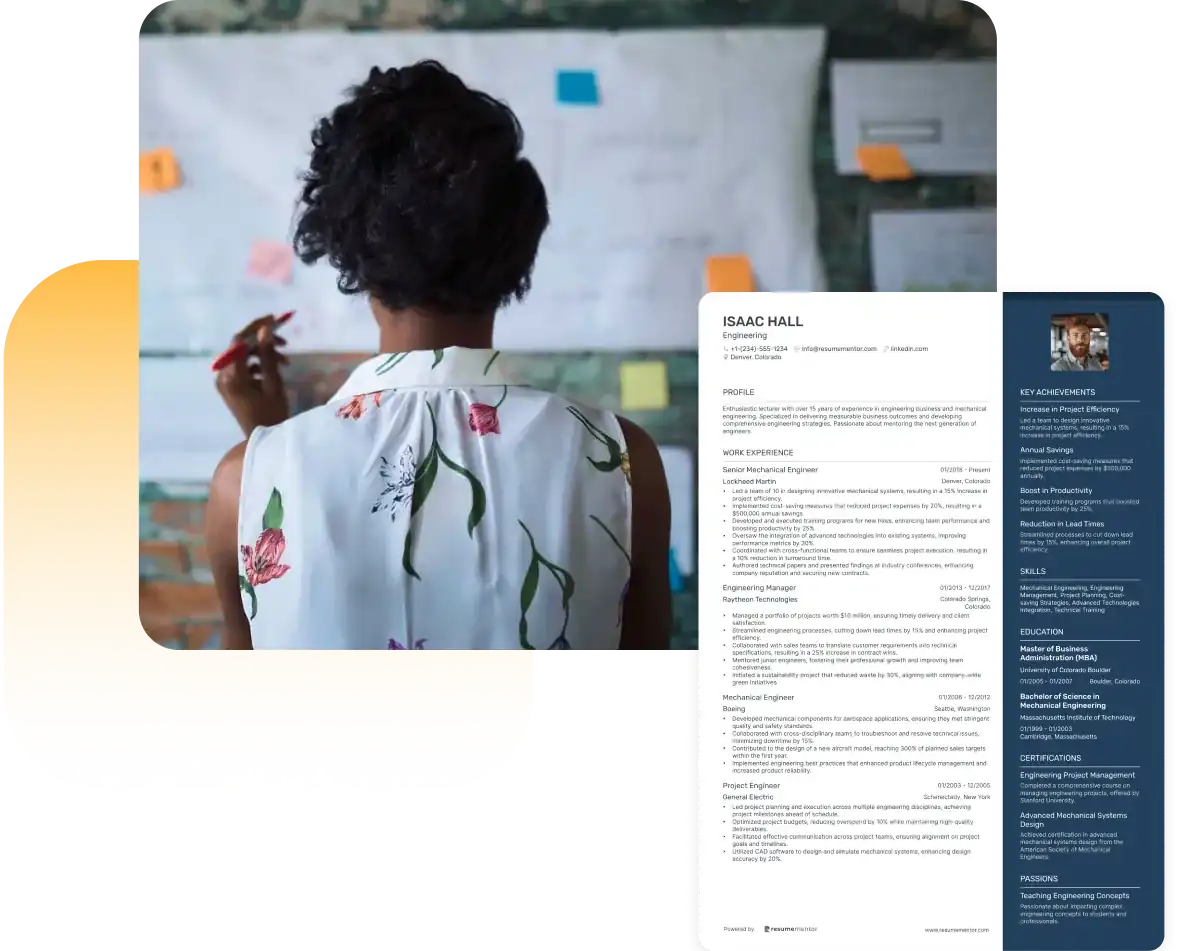
Continue Reading
Check more recommended readings to get the job of your dreams.
Resume
Resources
Tools
© 2025. All rights reserved.
Made with love by people who care.

